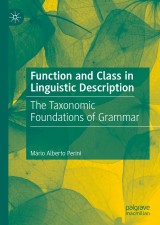Details

Function and Class in Linguistic Description
The Taxonomic Foundations of Grammar|
128,39 € |
|
| Verlag: | Palgrave Macmillan |
| Format: | |
| Veröffentl.: | 22.09.2021 |
| ISBN/EAN: | 9783030781736 |
| Sprache: | englisch |
Dieses eBook enthält ein Wasserzeichen.
Beschreibungen
<div>This book deals with the traditional problem of the classification of linguistic units, with a primary focus on word classes. The approach is descriptive rather than theoretical, and is based on the use of distinctive features analogous to the ones used in phonology, which entails a radical reworking of the traditional classification. The first part presents some basic notions such as the use of distinctive features and the role of word classes in grammar; classification by prototypes; and the use of world knowledge as a resource to assign thematic relations to constituents in the sentence. In the second part, some descriptive problems are examined, namely the classification of verbs according to valency; connectives, adverbs, and the internal constituents of the NP; and the classification of units larger than words. This book will be of use as a guide for linguists working on the description of natural languages, as well as a resource for students on courses in linguistic theory and description.</div>
Chapter 1: Introduction<div><br><div><div>Part I: General Principles</div><div><br></div><div>Chapter 2: Categorization and knowledge</div><div><br></div><div>Chapter 3: Form and meaning</div><div><br></div><div>Chapter 4: Word classes</div><div><br></div><div>Chapter 5: Classes and the grammar</div><div><br></div><div>Chapter 6: Prototypes</div><div><br></div><div>Chapter 7: Assignment by default.- Part II: Descriptive Application</div><div><br></div><div>Chapter 8: Classification of verbs</div><div><br></div><div>Chapter 9: Constructions of directional motion: a guided tour of valential complexity</div><div><br></div><div>Chapter 10: Functions and classes in the NP</div><div><br></div><div>Chapter 11: Towards a taxonomy of connectives</div><div><br></div><div>Chapter 12: Adverbs and their relatives</div><div><br></div><div>Chapter 13: Features and grammatical description</div><div><br></div><div>Chapter 14: Semantic correlations and syntactic features</div><div><br></div><div>Chapter 15: Beyond the lexicon</div><div><br></div><div>Chapter 16: Summary</div></div></div>
<p><b>Mário A. Perini</b> is Professor Emeritus at the Universidade Federal de Minas Gerais (UFMG), Belo Horizonte, Brazil. He is the author of <i>Describing Verb Valency </i>(2015) and <i>Thematic Relations</i> (2019).</p>
This book deals with the traditional problem of the classification of linguistic units, with a primary focus on word classes. The approach is descriptive rather than theoretical, and is based on the use of distinctive features analogous to the ones used in phonology, which entails a radical reworking of the traditional classification. The first part presents some basic notions such as the use of distinctive features and the role of word classes in grammar; classification by prototypes; and the use of world knowledge as a resource to assign thematic relations to constituents in the sentence. In the second part, some descriptive problems are examined, namely the classification of verbs according to valency; connectives, adverbs, and the internal constituents of the NP; and the classification of units larger than words. This book will be of use as a guide for linguists working on the description of natural languages, as well as a resource for students on courses in linguistic theory and description.<div><br></div><div><b>Mário A. Perini</b> is Professor Emeritus at the Universidade Federal de Minas Gerais (UFMG), Belo Horizonte, Brazil. He is the author of <i>Describing Verb Valency </i>(2015) and <i>Thematic Relations</i> (2019).<br></div>
<p>Proposes basic principles whereby lexical items, and also larger constituents, can be classified</p><p>Shows how the relation between linguistic elements and cognitive representations includes grammatically defined semantic roles</p><p>Demonstrates a way to make use of the notion of "prototype" in the analysis of language, without having recourse to vague and poorly defined relations between items</p>

















